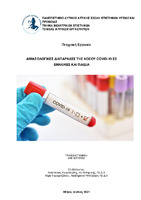| dc.contributor.advisor | Kriebardis, Anastasios | |
| dc.contributor.advisor | Georgatzakou, Chara | |
| dc.contributor.author | Γιαμαίου, Πολυξένη | |
| dc.date.accessioned | 2021-07-17T06:22:44Z | |
| dc.date.available | 2021-07-17T06:22:44Z | |
| dc.date.issued | 2021-07 | |
| dc.identifier.uri | https://polynoe.lib.uniwa.gr/xmlui/handle/11400/820 | |
| dc.identifier.uri | http://dx.doi.org/10.26265/polynoe-671 | |
| dc.description.abstract | Η τρέχουσα πανδημία της COVID-19 λοίμωξης προκλήθηκε από τον ιό SARS-CoV-2 και
μέχρι σήμερα (Ιούλιος 2021) ,έχουν καταγραφεί 183.551.119 κρούσματα και 3.973.942
θάνατοι παγκοσμίως. Η πορεία και η έκβαση της νόσου διαφέρουν μεταξύ των ασθενών
και τα συμπτώματα ποικίλλουν .Μολονότι πρόκειται για νόσο που εκδηλώνεται κυρίως
στο αναπνευστικό σύστημα , τα δεδομένα αποδεικνύουν ότι πρόκειται για
πολυσυστηματική νόσο που προσβάλλει μεταξύ άλλων το αιμοποιητικό και αγγειακό
σύστημα . Η λοίμωξη COVID-19 έχει σημαντική επίδραση στο αιμοποιητικό σύστημα ,
αλλά και στην αιμόσταση . Συχνά εργαστηριακά ευρήματα είναι η λεμφοπενία (χαμηλός
αριθμός λεμφοκυττάρων) και η μείωση του λόγου λεμφοκυττάρων/λευκοκυττάρων , δύο
παράμετροι με προγνωστική αξία για την εξέλιξη της νόσου. Η θρομβοπενία (μείωση του
αριθμού των αιμοπεταλίων) χαρακτηρίζει την COVID-19 λοίμωξη , ενώ η
υπερπηκτικότητα είναι πιο συνηθισμένη στους νοσηλευόμενους ασθενείς με COVID-19.
Οι διαταραχές της πήξης και το υψηλό ποσοστό των θρομβωτικών επεισοδίων είναι οι
πιο επικίνδυνες αιματολογικές διαταραχές και γι’ αυτό το λόγο προτείνεται η προληπτική
χορήγηση αντιπηκτικής αγωγής. Πτώση της αιμοσφαιρίνης παρατηρείται σε βαριές
μορφές της νόσου και αποδίδεται στη δράση των κυτταροκινών. Άλλες αιματολογικές
διαταραχές είναι η συστηματική υπερφλεγμονώδης κατάσταση που μοιάζει με
δευτεροπαθή αιμοφαγοκυτταρική λεμφοϊστοκυττάρωση , η θρομβωτική διαταραχή που
μοιάζει με Διάχυτη Ενδοαγγειακή Πήξη (ΔΕΠ), αλλά και το Πολυσυστηματικό
υπερφλεγμονώδες σύνδρομο (MIS-C -Multisystem inflammatory syndrome in children)
που μοιάζει με τη νόσο Kawasaki και επηρεάζει τα παιδιά .
Συμπερασματικά, απαιτείται στενή παρακολούθηση των αιματολογικών παραμέτρων
κατά τη διάρκεια της νόσου . Στη συγκεκριμένη διπλωματική εργασία αναλύονται οι
παραπάνω, καθώς και άλλες αιματολογικές διαταραχές που προκύπτουν στην COVID19 λοίμωξη. | el |
| dc.format.extent | 150 | el |
| dc.publisher | Πανεπιστήμιο Δυτικής Αττικής | el |
| dc.rights | Αναφορά Δημιουργού - Μη Εμπορική Χρήση - Παρόμοια Διανομή 4.0 Διεθνές | * |
| dc.rights | Attribution-NonCommercial-NoDerivatives 4.0 Διεθνές | * |
| dc.rights.uri | http://creativecommons.org/licenses/by-nc-nd/4.0/ | * |
| dc.subject | Covid-19 | el |
| dc.subject | Sars-CoV-2 | el |
| dc.subject | Πανδημία | el |
| dc.subject | Ερυθρά αιμοσφαίρια | el |
| dc.subject | Λευκά αιμοσφαίρια | el |
| dc.subject | Αιμοπετάλια | el |
| dc.subject | Αναιμία | el |
| dc.subject | Λεμφοπενία | el |
| dc.subject | Θρόμβωση | el |
| dc.subject | Θρομβοπενία | el |
| dc.subject | Αιματολογικές διαταραχές | el |
| dc.subject | Αιμορραγική διαταραχή | el |
| dc.subject | Αυτοάνοση αιμολυτική αναιμία | el |
| dc.subject | Καταιγίδα κυτταροκινών | el |
| dc.subject | Υπερ-φλεγμονώδες σύνδρομο | el |
| dc.subject | Υπερφερριτιναιμία | el |
| dc.subject | Νόσος Kawasaki | el |
| dc.subject | Πολυσυστηματικό φλεγμονώδες σύνδρομο σε παιδιά | el |
| dc.subject | Διάχυτη ενδοαγγειακή πήξη | el |
| dc.subject | Κορωναϊός | el |
| dc.title | Αιματολογικές διαταραχές της νόσου COVID-19 σε ενήλικες και παιδιά | el |
| dc.title.alternative | Hematological disorders of COVID-19 disease in adults and children | el |
| dc.type | Πτυχιακή εργασία | el |
| dc.contributor.committee | Kriebardis, Anastasios | |
| dc.contributor.committee | Georgatzakou, Chara | |
| dc.contributor.committee | Papageorgiou, Efstathia | |
| dc.contributor.faculty | Σχολή Επιστημών Υγείας & Πρόνοιας | el |
| dc.contributor.department | Τμήμα Βιοϊατρικών Επιστημών | el |
| dc.description.abstracttranslated | The current pandemic of COVID-19 infection was caused by the SARS-CoV-2 virus, and
more than 183.551.119 cases and 3.973.942 deaths have been recorded worldwide until
today (July 2021). The outcome of the disease and the symptoms vary between
patients. Although the involvement of the lower respiratory track accounts for most of the
morbidity and mortality seen, the virus affects several organ systems, such as the
hematopoietic and vascular systems. COVID-19 infection has a significant effect on the
hematopoietic system and on hemostasis. Lymphopenia, leukopenia, thrombocytopenia,
disseminated intravascular coagulation, and a prothrombotic state, are common
manifestations of COVID-19 and have important prognostic implications. Lymphopenia
(low lymphocyte count) and a decrease in the lymphocyte/white blood cell ratio are
common laboratory findings. These two parameters have a prognostic value for the
disease progression. Thrombocytopenia (reduction in platelet count) is also a common
finding, while hypercoagulability has been found in hospitalized patients. Coagulation
disorders and thrombotic events are the most dangerous hematological manifestations
and that is the reason why anticoagulant treatment has been suggested. Decreased
hemoglobin is observed in severe COVID-19 cases due to cytokine release. Moreover,
the systemic inflammatory response syndrome which resembles the Secondary
Hemophagocytic Lymphohistiocytosis SHLH, thrombotic disorders which resemble the
Disseminated intravascular coagulation, and the Multisystem inflammatory syndrome in
children (MIS-C), have been reported.
In conclusion, a close monitoring of hematological parameters, during the disease, is
required. At this bachelor's thesis, the above and other more hematological
manifestations resulting from COVID-19 infection, are presented. | el |


